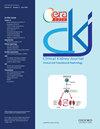透析液流量可以降到多低?关于节水透析处方的安全性和充分性的回顾性研究
IF 3.9
2区 医学
Q1 UROLOGY & NEPHROLOGY
引用次数: 0
摘要
绿色肾脏病学包括所有对气候和环境有积极影响的肾脏护理措施。透析液流量 (Qd) 设置为 500 毫升/分钟时,一次四小时的透析至少需要 120 升水。降低透析液流速可显著减少用水量。本研究的目的是检验将 Qd 从 500 毫升/分钟改为 300 毫升/分钟是否会对透析充分性产生重大影响。 该研究是一项回顾性分析。由于管理问题,一家卫星透析中心在一个月内将透析液流量降至 300 毫升/分钟。该中心再次将 Qd 提高到 500 毫升/分钟。我们分析了透析液流量减少前 3 个月、Qd 降为 300 毫升/分钟的当月以及 Qd 设为 500 毫升/分钟后 3 个月的实验室数据。 最终分析包括 24 人。降低 Qd 率对 URR 没有明显影响(64.50 [61.75-71.00] vs 67.00 [63.00-72.25] vs 69.00 [63.75-72.25],方差分析 F(2,46)=0.71,P=0.50)。同样,以 Kt/V 表示的血液透析充分性在任何 Qd 下都没有差异(1.23 [1.12-1.41] vs 1.25 [1.18-1.40] vs 1.35 [1.19-1.48],方差分析 F(2,46)=2.51, p=0.09)。Qd=500、300 和 500 毫升/分钟时,透析前平均 K 值分别为 5.18(95%CI 4.96-5.44) vs. 5.46(95%CI 5.23-5.69) vs. 5.23(95%CI 4.99-5.47)毫摩尔/升,P=0.039。 在这项小型研究中,将透析液流速降至 300 毫升/分钟似乎是安全的,不会造成任何短期负面影响。因此,我们也许可以通过节约用水达到类似的治疗效果。要确认这种方法的疗效,还需要进行更大规模的长期研究,并纳入患者报告的结果指标。本文章由计算机程序翻译,如有差异,请以英文原文为准。
How low can we go with the dialysate flow? A retrospective study on the safety and adequacy of a water-saving dialysis prescription
Green nephrology encompasses all initiatives in kidney care that have a positive impact on climate and environment. To prepare the dialysate at least 120 liters of water are needed for one four-hour session with a dialysate flow (Qd) set at 500 ml/min. Lower dialysate flow rate is associated with a significant reduction in the amount of water used. The aim of this study was to check whether change of Qd from 500 ml/min to 300 ml/min has a significant impact on dialysis adequacy.
The study was a retrospective analysis. Due to administrative issues a satellite dialysis center reduced dialysate flow to 300 ml/min for a month. The center again increased Qd to 500 ml/min. We analyzed laboratory data from 3 months before dialysate flow reduction, in the month with reduced Qd to 300 ml/min, and from 3 months thereafter with Qd set at 500 ml/min.
24 people were included in the final analysis. There were no significant changes in URR caused by lower rate of Qd (64.50 [61.75-71.00] vs 67.00 [63.00-72.25] vs 69.00 [63.75-72.25], ANOVA F(2,46)=0.71, p=0.50). Similarly, hemodialysis adequacy expressed by Kt/V did not differ at any Qd (1.23 [1.12-1.41] vs 1.25 [1.18-1.40] vs 1.35 [1.19-1.48], ANOVA F(2,46)=2.51, p=0.09). There was a small but statistically significant increase in mean predialysis K with lower Qd: (K = 5.18 (95%CI 4.96-5.44) vs. 5.46 (95%CI 5.23-5.69) vs. 5.23 (95%CI 4.99-5.47) mmol/l at Qd=500, 300, and 500 ml/min, respectively, p=0.039.)
Reduction in dialysate flow rate to 300 ml/min seems safe and does not cause any short-term negative effects in this small study. Thus, we might be able to achieve a similar therapeutic effect saving water consumption. Larger, long-term studies incorporating patient reported outcome measures are needed to confirm the efficacy of this approach.
求助全文
通过发布文献求助,成功后即可免费获取论文全文。
去求助
来源期刊

Clinical Kidney Journal
Medicine-Transplantation
CiteScore
6.70
自引率
10.90%
发文量
242
审稿时长
8 weeks
期刊介绍:
About the Journal
Clinical Kidney Journal: Clinical and Translational Nephrology (ckj), an official journal of the ERA-EDTA (European Renal Association-European Dialysis and Transplant Association), is a fully open access, online only journal publishing bimonthly. The journal is an essential educational and training resource integrating clinical, translational and educational research into clinical practice. ckj aims to contribute to a translational research culture among nephrologists and kidney pathologists that helps close the gap between basic researchers and practicing clinicians and promote sorely needed innovation in the Nephrology field. All research articles in this journal have undergone peer review.
 求助内容:
求助内容: 应助结果提醒方式:
应助结果提醒方式:


